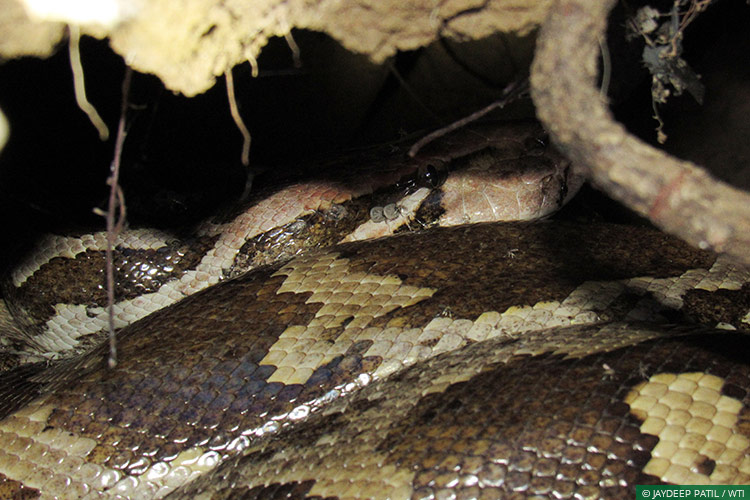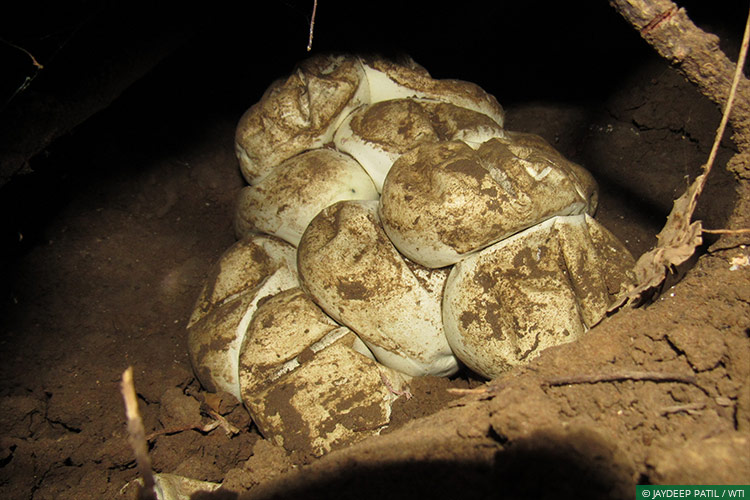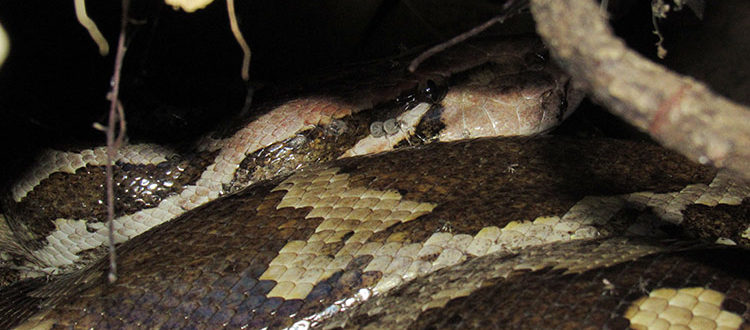Under Her Coils
By Jaydeep Patil

It was the first day of June and the Vidarbha skies were mercilessly devoid of clouds. The afternoon sun threatened to set us ablaze and I longed for the cool evening breeze. I was free in the evening and had decided to go for a swim at a nearby pond. A local had mentioned a place the villagers frequented. It was just on the edge of Brahmapuri, the town in Maharashtra near which Wildlife Trust of India’s (WTI) Vidarbha Tiger Project is based.
Evening came and I was off for that much needed swim. I asked around for the pond’s location only to hear an interesting story about it. One of the locals, after helping me with the directions, said something about a snake living there. I was confused as to why I was given this random piece of information. Nevertheless, the string had been plucked; my interest had been piqued. Now I was walking towards the pond with a new agenda in mind: SNAKE! It had been a long, tiring day, but the mere mention of a snake had given me a surge of excitement. I all but ran to my destination.
Reaching the pond, I saw quite a few people enjoying the water. Any other time I would have jumped right in but that was going to have to wait. I knew that this just might be a false tip. After all, snakes don’t really lounge around in the open all day. I attempted to get a handle on my wandering imagination; unsuccessfully. I asked an elderly gentleman if he had seen any snake near the pond.
With a partly suspicious and partly surprised expression, he growled, “No.”
I felt a wave of disappointment wash over me. As I was about to turn and leave, another fellow came up to me and asked, “Are you with the forest department?”
The python was a she. And she was coiled up around her eggs. I could see her contracting her muscles to produce the heat required for incubation.
I told them that I work with WTI; that I was there only to identify the snake and assess if there was a threat. Suddenly, I heard the same growling voice say, “Sir, there is no ‘saanp’ (snake) here but there is one ‘ajgar’ (python).” My heart skipped a beat at this point. “Have you seen it? Where?” I asked, to which they pointed at a large Babul tree behind them. I stared at the tree and noticed a peculiar detail: there was a large, rounded fencing of thorny branches at its base. As I walked towards the tree I realised I was being accompanied by almost half the people at the pond. They helped me move the four-feet-tall wall of thorns aside. I could see a big hollow underneath the tree. And there it was; some seven feet of raw power coiled up in the hollow. I watched it with utter joy and awe. There was something white beside it. It looked like a crumpled piece of paper. I took a closer look inside the hollow and realised that it was an egg. The python was a she. And she was coiled up around her eggs. I could see her contracting her muscles to produce the heat required for incubation.
It came to my attention that the burrow looked disturbed. There were signs indicating that a shovel had been used to dig up the place. I asked the villagers about this.
“Sir, there is one local snake catcher. He came here a few days ago and dug the burrow up. He said that he will relocate her somewhere safe.”
“Did he harm her in any way?” I asked.
“No. We all stopped him. We told him to go away. The python is not doing anything to anybody. She is not harming us, so why should we harm her? After her babies are born, she will go away on her own.”
The elderly gentleman went on to inform me that the snake catcher had stolen one of the eggs. “We all went to his house that night and told him to return the egg. He was not agreeing so we threatened to call the police. Then he gave us the egg.”

As furious as I was upon hearing about the theft of the egg, I was equally in admiration of the villagers’ action. “Where is that egg?” I asked in concern.
Another fellow answered, “We placed it with the mother. I kept it next to her myself.”
In a country where snakes generally receive the bad end of the stick, it is heartening to have met a community that extends such protection and compassion towards wildlife.
I carefully took a closer look at the egg which sat outside her protective coils. It was clear to me that it was not going to hatch. It had a crack through which a tiny trail of ants was bustling.
“Will the baby come out of that egg?” asked a tiny voice from behind me.
It was a little girl holding her father’s hand and standing on her toes, trying to get a peek inside the burrow. Her eyes brimmed with wild curiosity and genuine concern. And I did not have the heart to tell her the truth.
Darkness fell and the crowd thinned. The remaining people fenced up the burrow again. The few who stayed behind told me that initially they had thought I was another snake catcher. They had lied about the presence of the snake to protect her and her eggs. “We keep a watch on her. Make sure no one harms or disturbs her. She has been here for quite some time. So let her be and she will be on her way soon. That is the way of nature.”
In a country where snakes generally receive the bad end of the stick (pun intended), it is heartening to have met a community that extends such protection and compassion towards wildlife. The people have been protecting the Python Mama. And with such protectors keeping watch, I know her unhatched little ones will be safe under her coils.
The author is an Assistant Field Officer with Wildlife Trust of India’s Vidarbha Tiger Project









